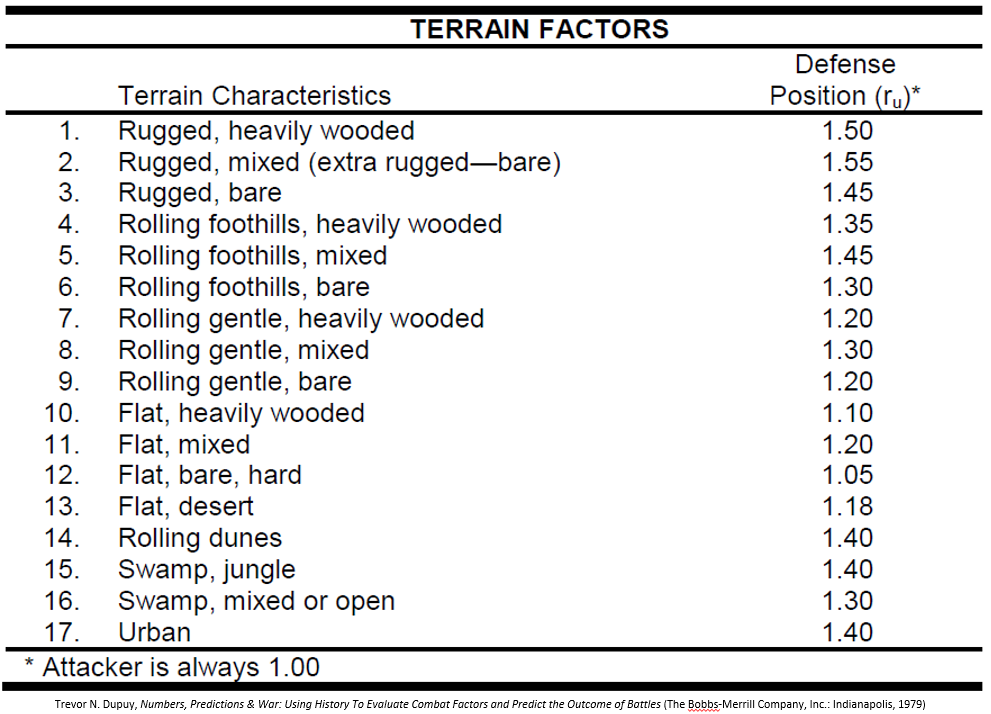The second of Trevor Dupuy’s Timeless Verities of Combat is:
Defensive strength is greater than offensive strength.
From Understanding War (1987):
[Prussian military theorist, Carl von] Clausewitz expressed this: “Defense is the stronger form of combat.” It is possible to demonstrate by the qualitative comparison of many battles that Clausewitz is right and that posture has a multiplicative effect on the combat power of a military force that takes advantage of terrain and fortifications, whether hasty and rudimentary, or intricate and carefully prepared. There are many well-known examples of the need of an attacker for a preponderance of strength in order to carry the day against a well-placed and fortified defender. One has only to recall Thermopylae, the Alamo, Fredericksburg, Petersburg, and El Alamein to realize the advantage enjoyed by a defender with smaller forces, well placed, and well protected. [p. 2]
The advantages of fighting on the defensive and the benefits of cover and concealment in certain types of terrain have long been basic tenets in military thinking. Dupuy, however, considered defensive combat posture and defensive value of terrain not just to be additive, but combat power multipliers, or circumstantial variables of combat that when skillfully applied and exploited, the effects of which could increase the overall fighting capability of a military force.
The statement [that the defensive is the stronger form of combat] implies a comparison of relative strength. It is essentially scalar and thus ultimately quantitative. Clausewitz did not attempt to define the scale of his comparison. However, by following his conceptual approach it is possible to establish quantities for this comparison. Depending upon the extent to which the defender has had the time and capability to prepare for defensive combat, and depending also upon such considerations as the nature of the terrain which he is able to utilize for defense, my research tells me that the comparative strength of defense to offense can range from a factor with a minimum value of about 1.3 to maximum value of more than 3.0. [p. 26]
The values Dupuy established for posture and terrain based on historical combat experience were as follows:

 For example, Dupuy calculated that mounting even a hasty defense in rolling, gentle terrain with some vegetation could increase a force’s combat power by more than 50%. This is a powerful effect, achievable without the addition of any extra combat capability.
For example, Dupuy calculated that mounting even a hasty defense in rolling, gentle terrain with some vegetation could increase a force’s combat power by more than 50%. This is a powerful effect, achievable without the addition of any extra combat capability.
It should be noted that these values are both descriptive, in terms of defining Dupuy’s theoretical conception of the circumstantial variables of combat, as well as factors specifically calculated for use in his combat models. Some of these factors have found their way into models and simulations produced by others and some U.S. military doctrinal publications, usually without attribution and shorn of explanatory context. (A good exploration of the relationship between the values Dupuy established for the circumstantial variables of combat and his combat models, and the pitfalls of applying them out of context can be found here.)
While the impact of terrain on combat is certainly an integral part of current U.S. Army thinking at all levels, and is constantly factored into combat planning and assessment, its doctrine does not explicitly acknowledge the classic Clausewitzian notion of a power disparity between the offense and defense. Nor are the effects of posture or terrain thought of as combat multipliers.
However, the Army does implicitly recognize the advantage of the defensive through its stubbornly persistent adherence to the so-called 3-1 rule of combat. Its version of this (which the U.S. Marine Corps also uses) is described in doctrinal publications as “historical minimum planning ratios,” which proscribe that a 3-1 advantage in numerical force ratio is necessary for an attacker to defeat a defender in a prepared or fortified position. Overcoming a defender in a hasty defense posture requires a 2.5-1 force ratio advantage. The force ratio advantages the Army considers necessary for decisive operations are even higher. While the 3-1 rule is a deeply problematic construct, the fact that is the only quantitative planning factor included in current doctrine reveals a healthy respect for the inherent power of the defensive.
